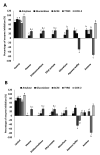Antioxidant, Antimicrobial, and Bioactive Potential of Two New Haloarchaeal Strains Isolated from Odiel Salterns (Southwest Spain)
- PMID: 32962162
- PMCID: PMC7564620
- DOI: 10.3390/biology9090298
Antioxidant, Antimicrobial, and Bioactive Potential of Two New Haloarchaeal Strains Isolated from Odiel Salterns (Southwest Spain)
Abstract
The need to survive in extreme environments has furnished haloarchaea with a series of components specially adapted to work in such conditions. The possible application of these molecules in the pharmaceutical and industrial fields has received increasing attention; however, many potential bioactivities of haloarchaea are still poorly explored. In this paper, we describe the isolation and identification of two new haloarchaeal strains from the saltern ponds located in the marshlands of the Odiel River, in the southwest of Spain, as well as the in vitro assessment of their antioxidant, antimicrobial, and bioactive properties. The acetone extract obtained from the new isolated Haloarcula strain exhibited the highest antioxidant activity, while the acetone extracts from both isolated strains demonstrated a strong antimicrobial activity, especially against other halophilic microorganisms. Moreover, these extracts showed a remarkable ability to inhibit the enzyme cyclooxygenase-2 and to activate the melanogenic enzyme tyrosinase, indicating their potential against chronic inflammation and skin pigmentation disorders. Finally, the aqueous protein-rich extracts obtained from both haloarchaea exhibited an important inhibitory effect on the activity of the acetylcholinesterase enzyme, involved in the hydrolysis of cholinergic neurotransmitters and related to several neurological diseases.
Keywords: anti-inflammatory; antimicrobial; antioxidant; bioactive substances; haloarchaea.
Conflict of interest statement
The authors declare no conflict of interest. The funders had no role in the design of the study; in the collection, analyses, or interpretation of data; in the writing of the manuscript, or in the decision to publish the results.
Figures





Similar articles
-
Biochemical Characterization of the Amylase Activity from the New Haloarchaeal Strain Haloarcula sp. HS Isolated in the Odiel Marshlands.Biology (Basel). 2021 Apr 16;10(4):337. doi: 10.3390/biology10040337. Biology (Basel). 2021. PMID: 33923574 Free PMC article.
-
Characterization of a bacterioruberin-producing Haloarchaea isolated from the marshlands of the Odiel river in the southwest of Spain.Biotechnol Prog. 2016 May;32(3):592-600. doi: 10.1002/btpr.2248. Epub 2016 Feb 26. Biotechnol Prog. 2016. PMID: 26871874
-
Up-Regulation of the Nrf2/HO-1 Antioxidant Pathway in Macrophages by an Extract from a New Halophilic Archaea Isolated in Odiel Saltworks.Antioxidants (Basel). 2023 May 11;12(5):1080. doi: 10.3390/antiox12051080. Antioxidants (Basel). 2023. PMID: 37237946 Free PMC article.
-
Haloarchaeal Carotenoids: Healthy Novel Compounds from Extreme Environments.Mar Drugs. 2019 Sep 6;17(9):524. doi: 10.3390/md17090524. Mar Drugs. 2019. PMID: 31500208 Free PMC article. Review.
-
Systematics of haloarchaea and biotechnological potential of their hydrolytic enzymes.Microbiology (Reading). 2017 May;163(5):623-645. doi: 10.1099/mic.0.000463. Epub 2017 May 26. Microbiology (Reading). 2017. PMID: 28548036 Review.
Cited by
-
Antioxidant Capacity of Carotenoid Extracts from the Haloarchaeon Halorhabdus utahensis.Antioxidants (Basel). 2023 Oct 10;12(10):1840. doi: 10.3390/antiox12101840. Antioxidants (Basel). 2023. PMID: 37891919 Free PMC article.
-
Biochemical Characterization of the Amylase Activity from the New Haloarchaeal Strain Haloarcula sp. HS Isolated in the Odiel Marshlands.Biology (Basel). 2021 Apr 16;10(4):337. doi: 10.3390/biology10040337. Biology (Basel). 2021. PMID: 33923574 Free PMC article.
-
The Methods of Digging for "Gold" within the Salt: Characterization of Halophilic Prokaryotes and Identification of Their Valuable Biological Products Using Sequencing and Genome Mining Tools.Genes (Basel). 2021 Nov 1;12(11):1756. doi: 10.3390/genes12111756. Genes (Basel). 2021. PMID: 34828362 Free PMC article. Review.
-
Novel Halotolerant Bacteria from Saline Environments: Isolation and Biomolecule Production.BioTech (Basel). 2025 Jun 19;14(2):49. doi: 10.3390/biotech14020049. BioTech (Basel). 2025. PMID: 40558398 Free PMC article.
-
Marine Carotenoids: Unlocking Advanced Antioxidant Mechanisms and Therapeutic Applications for Oxidative Stress.Mol Biotechnol. 2025 Mar 25. doi: 10.1007/s12033-025-01420-w. Online ahead of print. Mol Biotechnol. 2025. PMID: 40131636 Review.
References
Grants and funding
LinkOut - more resources
Full Text Sources
Molecular Biology Databases
Research Materials

